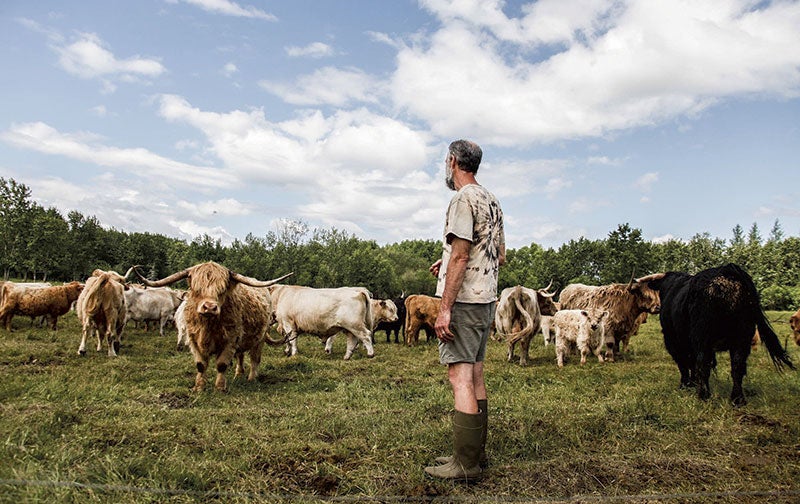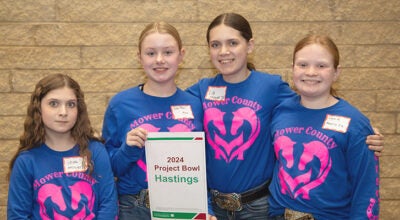As foodies seek local, Midwest farmers go global
Published 7:49 am Wednesday, July 26, 2017

- Owner Paul Conklin looks out at his grass-fed beef cattle at Northern Light Farm in Solway, Minn., on July 7, 2017. Besides cattle, Conklin grows fruit and vegetables that he sells to a local farmers market and community supported agriculture subscribers. Maria Alejandra Cardona/MPR News
By Elizabeth Dunbar
MPR News/90.1 FM
A Minneapolis cafe serves up oat milk lattes, locally grown greens and a chocolate-caramel dessert bar made with perennial wheat grass flour. Its owners, chefs and customers bet on a future in which dramatic shifts toward a local, diverse and resilient food system are necessary to sustain life itself.
But just miles from the bustling farmers markets, craft breweries and farm-to-table restaurants of the Twin Cities, a more traditional Midwest is thriving too: fields of corn and soybeans as far as the eye can see, hog barns, grain elevators, ethanol and meatpacking plants.
These coexisting, contradictory worlds tug at Scott Haase and a growing number of Midwestern corn and soybean farmers.
On the one hand, they face heightened expectations for environmental stewardship and want to build healthy soils that can withstand heat, drought and heavy rain. On the other, farming is a day-to-day, season-to-season calculation of inputs and outputs — an integral piece of a complex and growing global food system.
From atop a grain bin, Haase can look out at the fields he farms with his dad and brother in Blue Earth, Minn., near the Iowa border. The field where he planted cover crops alongside the corn has none of the yellow patches he sees in a neighbor’s field. Yet, it’s still unclear how well the extra $30 per acre in seed costs will translate into monetary benefits.
“I’m pretty confident that after this year, the nutrient density of the crop is going to be higher,” Haase said, listing multiple other benefits: healthier soil that stores more carbon and retains water; less commercial fertilizer; reduced polluted runoff to nearby streams and rivers.
But right now, he said, the market doesn’t care about all that. “It’s just going in with the rest,” Haase said.
He dreams of a day when the Midwest landscape is much more diverse, where cover crops, perennial grains and grazing cattle rebuild the soil while also sustaining farmers and their families. That day seems far off.
“You’ve still got to make a living out here,” said Ken Haase, Scott’s dad, pausing from a brake job on the semitrailer they use to haul corn to the local ethanol plant.
“Sure, it’d be great to grow a bunch of small grains and different things, but if you’ve got to pay a big rent bill or you have some big land costs, you don’t have a lot of choices,” he said.
When Scott suggested tilling the soil less and adding cover crops, Haase raised an eyebrow.
“I’m always kind of leery of change. Any farmer that’s farmed for 40 years would be, I think,” he said.
Besides everyone who drives a car with a gas tank, the Haase farm and the thousands of others like it are also feeding animals. Meat is a staple in the American diet, and countries around the world have become more reliant on U.S. meat production.
The annual World Pork Expo in Des Moines, Iowa, provides a glimpse of that. Visitors from nearly 40 countries come together on the Iowa State Fairgrounds to taste barbecued pork done up dozens of ways and see the latest barn-ventilation and manure-management technologies.
A quarter of U.S. pork goes for export. Japan and Mexico are the top buyers. Exports of U.S. beef and poultry are big, too.
“If you think about it, 95 percent of the world’s population lives outside our borders,” said Bill Luckey, a Nebraska pork producer who has been on delegations to places like Colombia and China.
For the full story go to: https://www.mprnews.org/newspartners/story/2017/07/25/foodsystem-as-foodies-seek-local-midwest-farmers-go-global



